Varroa impacts continue
 New South Wales beekeepers are facing the challenge of living with the varroa mite, a deadly pest that continues to spread across the state.
New South Wales beekeepers are facing the challenge of living with the varroa mite, a deadly pest that continues to spread across the state.
Three months after NSW abandoned efforts to eradicate the pest, many in the industry are left grappling with uncertainty and concern for the future.
The Varroa destructor mite, first detected in New South Wales in June 2022, has been a major concern for Australian beekeepers.
Australia was, until recently, the only major honey-producing country free of this invasive pest.
The NSW Department of Primary Industries (DPI) led a 15-month campaign to eliminate the mite, an effort that included euthanising billions of bees and imposing movement restrictions in affected areas. However, eradication was ultimately deemed unattainable.
Danny Le Feuvre, Chief Executive of the Australian Honey Bee Industry Council, says the impact of varroa has been “unmeasurable”, with many beekeepers “having to make the sacrifice for industry and then deciding that it's not achievable”.
He emphasised the importance of education and training in restoring confidence, preparing beekeepers to manage the pest effectively.
Shannon Mulholland, DPI Deputy Incident Controller for the varroa mite response, says there are plans for “a significant level of training” in the new year.
Despite the spread of the mite, she says she anticipates a “slow and measured” pace of expansion, providing time for industry upskilling.
Compounding the challenge, recent scientific research has shed light on the wider implications of varroa infestations.
Studies involving honeybee colonies in several countries, including New Zealand, have discovered that colonies with varroa infestations experience a rise in lethal viruses.
The mites not only transmit some viruses directly, such as the deformed wing virus, but also facilitate the spread of other "hitchhiker" viruses in weakened colonies.
The research, examining historical honeybee samples from Europe, New Zealand, and North America, found significant changes in honeybee virus composition following the spread of varroa.
Lethal viruses increased in prevalence and abundance in the presence of the mite, highlighting its joint role in the high mortality of honeybee colonies.
This dual challenge of managing varroa mites and mitigating virus spread presents a complex scenario for Australian beekeepers.







 Print
Print